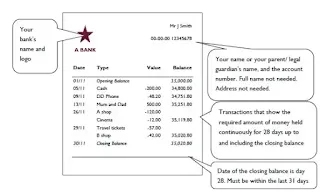Bank Statement: What is a bank statement?
A bank statement which is sometimes called account statement is a document issued by a bank to a depositor describing the activities in a depositor’s savings account or current account during a given period. With the help of bank statement, account holders can track their transactions and account.
The bank statement is normally issued by a bank on a monthly basis. It is a common practice for a business to have a bank statement compiled to coincide with their accounting period end.
Bank statements are issued in the post or accessed by the customer online (paperless statements) via e-mail. If you have a high number of transactions in your account, it is important to check your bank statement on a regular basis.
The bank statement details all deposits and all withdrawals made through the bank account, including any direct debits or standing orders for a period.
The bank statement is normally issued by a bank on a monthly basis. It is a common practice for a business to have a bank statement compiled to coincide with their accounting period end.
Bank statements are issued in the post or accessed by the customer online (paperless statements) via e-mail. If you have a high number of transactions in your account, it is important to check your bank statement on a regular basis.
The bank statement details all deposits and all withdrawals made through the bank account, including any direct debits or standing orders for a period.
Parts of an Account Statement
There are three parts of an account statement contains, they are:- Account holder Details
- Account Details
- Transaction history
The account holder details are written at the top of the account statement. The details include Name, registered mobile number, e-mail address and residential address.
After account holder information, account summary is presented that holds the account number, home address, account description (type of account) and other details of the depositor.
The transaction detail part shows the summary of all transactions recorded with date, amount, and the description of the payee (receiver) or payer (sender).
A customer can choose the statement period for which he/she wants the bank statement. For eg: the customer can tell the bank that he/she wants a statement of account for the past five years, one year, six months, one months, etc.
After account holder information, account summary is presented that holds the account number, home address, account description (type of account) and other details of the depositor.
The transaction detail part shows the summary of all transactions recorded with date, amount, and the description of the payee (receiver) or payer (sender).
A customer can choose the statement period for which he/she wants the bank statement. For eg: the customer can tell the bank that he/she wants a statement of account for the past five years, one year, six months, one months, etc.
Special Considerations
Many banks give account holders the option of receiving paper statements which will be handed over to the customer in the bank or using paperless, electronic ones, usually delivered through email. An electronic version of a bank statement is called an electronic statement or e-statement and allows account holders to access their statements online where they can download or print it. Some banks sends statements to customers as an attachment through e-mail. Some bank automatic teller machines (ATMs) can print a summarized version of a bank statement, called a transaction history.
What’s Included In A Bank Statement
A bank statement provides a comprehensive overview of your account over the previous month. It will include:- The beginning and ending balances of the account
- Deposits which can take the form of income, cash deposits, etc.
- Withdrawals in the form of cash, cheques, etc.
- Any interest that was made on the account
- Any bank fees or charges for service
Once you understand the concept of debit the receiver and credit the giver in accounting, then the accounting for bank entries will not be difficult to understand.
For depositing entries (money paid into your bank account) the accounting entries to be recorded would be a debit to your bank account (receiver) and a credit to customer who has paid the money (giver).
Likewise, when paying money out of your bank account, the entries in your accounting system would credit your bank account (giver) because you are giving out and debit the supplier who received the money.
However, if you look through your bank statement you will discover that these entries are opposite to the ones you will be processing. The reason is because, from the bank’s point of view, your business is a creditor. A bank treats user transactions as a business, bank customers then see the customer side of the transactions. This is one of the main reasons why understanding debit and credit is very difficult.
For depositing entries (money paid into your bank account) the accounting entries to be recorded would be a debit to your bank account (receiver) and a credit to customer who has paid the money (giver).
Likewise, when paying money out of your bank account, the entries in your accounting system would credit your bank account (giver) because you are giving out and debit the supplier who received the money.
However, if you look through your bank statement you will discover that these entries are opposite to the ones you will be processing. The reason is because, from the bank’s point of view, your business is a creditor. A bank treats user transactions as a business, bank customers then see the customer side of the transactions. This is one of the main reasons why understanding debit and credit is very difficult.












